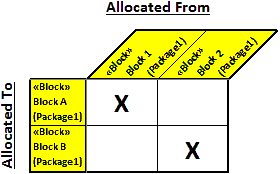Allocation matrix (SysML diagram)

An Allocation Matrix shows how items and diagrams in specific Packages are allocated to or from other items and diagrams.
Create an Allocation Matrix from the Model or a Package: right-click the Model or Package, point to New, point to SysML, point to Allocations, and then click Allocation Matrix. After creating an Allocation Matrix, you can open it: right-click the Allocation Matrix, and then click Open.
When you open an Allocation Matrix, Modeler creates a matrix that can be generated as HTML for viewing in your Internet browser, or generated as a Microsoft Excel spreadsheet for viewing in Microsoft Excel. To specify how matrices and tables are opened for a model: in the Packages pane, right-click the Model, and select > , click Matrix/Table Generation Format, and then select HyperTextMarkupLanguage_HTML or Excel_XLS. Each time you open an Allocation Matrix, Modeler populates that matrix with the latest data from the model.

The rows of an Allocation Matrix represent items and diagrams that are allocated to other items or diagrams. In the preceding example, Block 1 and Block 2 are allocated to other items or diagram.
The columns of an Allocation Matrix represent items and diagrams that are allocated from other items or diagrams. In the preceding example, Block A and Block B are allocated from other items or diagrams.
When a cell contains an X, the row item or diagram is allocated to the column item or diagram. In the preceding example, Block 1 is allocated to Block A, and Block 2 is allocated to Block B.
If no allocated items or diagrams are found in the Analyzed Packages, the Allocation Matrix will be empty.
You can customize the content and presentation of an Allocation Matrix:
• You can specify the Packages that are searched for items.
By default, a new Allocation Matrix searches for allocated items in the Package that owns the Allocation Matrix. To specify which Packages are searched for allocated items: right-click the Allocation Matrix, point to Links, and then click Analyzed Packages. Select the Packages you want to search, or Unlink All Packages to search all Packages in the model for allocated items.
• You can choose whether to show the scope of row and column items.
On the AllocationMatrix tab of the Allocation Matrix's Property Pages, set the tagged value of the rowItemsShowScope tag definition to TRUE to show row item scoping, or FALSE to show only the row item names. Set the tagged value of the columnItemsShowScope tag definition to TRUE to show column item scoping, or FALSE to show only the column item names.
• You can change the row and column labels.
On the AllocationMatrix tab of the Allocation Matrix's Property Pages, set the tagged value of the rowLabel tag definition to the row label you want, and set the tagged value of the columnLabel tag definition to the column label you want.
The Allocation Matrix is based on the Custom Matrix. For additional information about how Custom Matrices can be customized, including changing which items are included in the matrix, see the following topics:
The Allocation Matrix is a UML Text Diagram that is stereotyped by the «Allocation Matrix» stereotype from the SysML profile.
An Allocation Matrix is an editable matrix. For more information about editable matrices, see Editing Matrices.
The following sections provide information about how an Allocation Matrix is used in the model. For more information about a SysML item - click it.
Owned by
 Model (UML item)
Model (UML item) Package (UML item)
Package (UML item)Creates or shows these items
Any model item or diagram that is allocated can be shown on an Allocation Matrix.
SysML Properties
The Allocation Matrix is based on the Custom Matrix. For information about how the following SysML Properties can be used to customize an Allocation Matrix, see the following topics:
• analyzedPackages - shows the Packages that are searched for items. To specify the Packages that are searched: right-click the Allocation Matrix, point to Links, and then click Analyzed Packages. To search all Packages in the model, click the Unlink All button.
• cellDisplayProperty- specifies the property of the Allocation to display in intersection cells. When blank, the default value, an X is displayed in intersection cells.
• columnItemsRole - specifies the role to use for finding items from the columnItemsStartPoint.
• columnItemsShowScope - specifies whether the scoping of column items is shown after the item name. Set to TRUE to show item scoping, or FALSE to show only item names.
• columnItemsStartPoint - specifies the start point for finding column items.
• columnLabel - specifies the label for the column items.
• columnToRowIntersectionRole - specifies the role to use for column item to row item intersections.
• matrixType - internal property that cannot be changed.
• rowItemsRole - specifies the role to use for finding items from the rowItemsStartPoint.
• rowItemsShowScope - specifies whether the scoping of row items is shown after the item name. Set to TRUE to show item scoping, or FALSE to show only item names.
• rowItemsStartPoint - specifies the start point for finding row items.
• rowLabel - specifies the label for the row items.
• rowToColumnIntersectionRole - specifies the role to use for row item to column item intersections.
